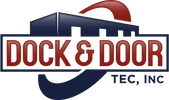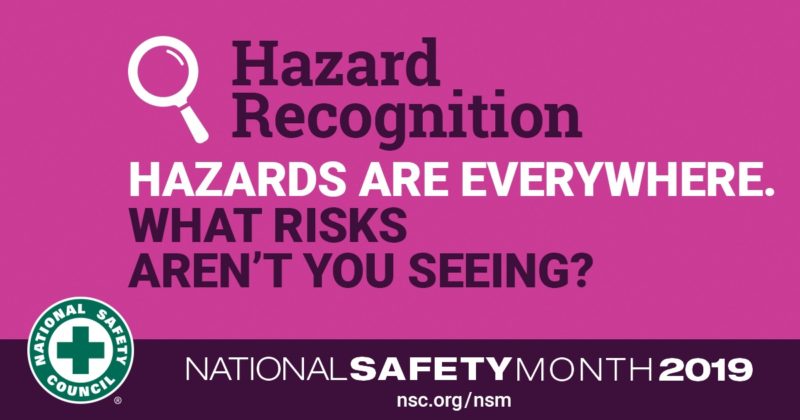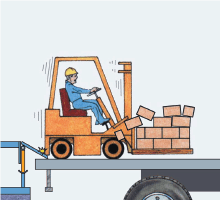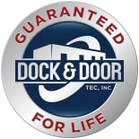|
We see hazards every day in our personal lives – the texting driver, the kid running across the street, the unsecured cargo in the back of a pickup. But do we see the hazards at our warehouse? Or have we gotten so used to things just working that we don’t see the dangers they pose if they don’t?
About 25% of all industrial accidents happen at the loading dock. For each reported accident there are as many as 600 near misses…that’s a scary number. Forklifts, pedestrians, debris and other hazards, faulty equipment, human error, and countless other reasons are to blame. Many of these can be avoided by developing and enforcing clear and comprehensive safety practices, providing top-notch employee safety training, and repairing or replacing old or faulty loading dock equipment. As we visit our clients the most common hazards we see are: 1. No truck restraints or wheel chocks at all loading docks Lack of truck restraints, be it wheel chocks or mechanical restraints, can cause a multitude of very serious problems; trailer creep being the biggest and scariest of them. Trailer creep is when the trailer of the truck “creeps” away from the dock. This can cause separation between the dock lip and the trailer itself. Once that separation gets big enough the weight and constant back and forth motion of the forklift could cause the lip to fall down or break, taking the forklift and the driver with it. This could result in serious injury or death and major equipment damage. Impatient drivers or unclear communication between drivers and dock workers can cause early truck departure – resulting in the same situation or worse. Wheel chocks can certainly help but are not always the best choice. They have drawbacks that can make them an unreliable means of securing a trailer in your dock. But they are better than nothing. If you are using wheel chocks only, make sure to train your staff on how to properly use them and how to safely and effectively communicate with your truck drivers. You also need to have a process in place for inspecting your chocks and assessing their condition so you know when its time to replace them. Broken, missing, or misused wheel chocks are as bad as not having any at all. Check out the articles below for some basic information and facts on loading dock safety and the crucial role that vehicle restraints can play. Prevent Trailer / Dock Separation Incidents (MH&L) Stay Safe: 8 Tips to Ensure Loading Dock Safety (Load Delivered) 5 Loading Dock Catastrophes (and How to Prevent Them) (safeopedia) 2. Missing or improper entrapment devices on doors As the name states these devices prevent someone from becoming entrapped under your door. Overhead door systems are frequently overlooked as safety hazards, even in companies with excellent safety programs. Quite simply, if they are working, we kind of forget about them. Commercial doors are heavy, many hang high in the air, and in the interest of efficiency can operate quickly. Besides being an OSHA safety violation, missing or improper entrapment devices is an opportunity for a serious accident to occur. A person or even a forklift can easily get trapped under a door that isn’t set up correctly to prevent entrapment. There are different options and different devices that can prevent this from happening, depending on how your facility and equipment are set up and used. The proper entrapment devices can save thousands in equipment damage and prevent a serious injury from happening. 3. Missing fall protection This is a commonly overlooked safety component because we usually don’t see the docks empty and the doors open. But what about those beautiful spring & summer days when you open the doors to let a nice breeze in. What protects your employees and equipment then? While it may be a simple thing to ignore, OSHA standard 29 CFR 1910.23(b) relating to protection for wall openings and holes requires fall protection for openings where there is a drop of 48″ or more. We recommend fall protection wherever you have an opening that a forklift, person, or other equipment could fall from and cause injury. As with most things, there is a wide variety of fall protection equipment available depending on your facility, your budget, and the frequency of use. OSHA Requirements Many times we reference OSHA standards in our industry and while it is a great tool and great organization, we consider their requirements to be the bare minimum. Your facility and your industry may have standards that far exceed the OSHA requirements and that is a very good thing. Make sure when laying out your safety plans or adding safety equipment that you take into consideration how it will be used, what equipment is going to be affected by it, and how your employees can easily and safely implement your safety practices. Keep the bare minimum in mind, but plan and build for the reality of your situation. We hope this has given you some helpful information, as well as some things to consider checking or adding to your facility to improve your safety systems. Check out our other blogs on Loading Dock Safety and Risk Assessment for more helpful tips. We are here to help if you have any concerns or questions please Contact Us today for a no-obligation safety and OSHA compliance check Stump-out? Like the chemical that is used to get rid of unwanted tree stumps? What does that have to do with loading dock equipment? No, we’re not talking about that kind of stump-out. In the loading dock industry stump-out is an all too common problem and huge cost of ownership with mechanical dock levelers that can wreak havoc and create a hazardous work area.
What is it? Ironically enough, stump-out is caused by pieces of the dock meant to keep it safe. Stump-out occurs on mechanical dock levelers when the mechanical fall safe legs contact their stops. The legs then interfere with the vertical movement of a dock leveler that naturally occurs during loading and unloading. Stump-out can also occur when mechanical fall safe legs can be manually released by pulling a release activator in the dock leveler deck assembly. The release is required every time the dock leveler must pass the below the stop position of the mechanical fall safe legs. Upward movement during use can cause the safety leg to reset to the stored position. How do I know if I have stump-out? Take a look at your dock while it’s in use. Does it look like this? Do your forklift drivers complain about big bumps or jarring stops going in and out of trucks? Do your forklifts have tire damage that isn’t normal wear and tear? Does your product ever take a spill off pallets while being loaded or unloaded? If so, you probably have a stump-out situation happening. The consequences No matter how it happens, stump-out creates a steep incline of the lip. That, in turn, causes any lift truck to be severely jarred or stopped completely when trying to exit a truck, causing possible injury to the driver or damage to any product being moved, the lift truck, or the leveler itself. While there are designs and versions of mechanical fall safe legs that can remain retracted until they are required, they do not always activate like they should. Many times they are activated by lip rotation or speed sensing. Rollers and spring-loaded cross-traffic legs do not solve the stump out problem and add to the cost of ownership. They are high failure rate parts and are in constant danger and motion during loading and unloading. All of which will cost you time and money. Lots of time and money. In some cases, there are as many as 20-30 parts for EACH mechanical fall safe leg that can fail. Over and over again. With some of our own clients, we have seen repair bills that would have covered the difference of purchasing a hydraulic leveler in the first place. And would have more than covered the cost of a hydraulic conversion. Stump-out also poses a major safety risk to your employees. Constant jarring and sudden stops can cause back and neck injuries. In turn, costing you downtime due to injury and potential worker’s compensation claims. As well as employee safety, what about your equipment? The jarring and sudden stops cause repeated damage to your forklifts and other equipment that will all-cause premature wear and tear. Meaning you will need more maintenance and sooner replacement. All causing you downtime and efficiency deficiency. How to fix it? Instead of throwing parts and money away trying to fix a problem that will keep happening no matter how good your service team is, address the problem head-on. Most loading dock companies are representing a single manufacturer and have a very limited number of solutions. As an independent loading dock service & repair company, we have options that work for all situations. We will assess your situation and work with our partners to design a solution that works for your facility and your budget. For more information, contact us and we will provide a solution for this potentially costly and hazardous problem. Now that the groundhog has gifted us with another six weeks of winter it’s time to sit back, enjoy a warm beverage, and write a quick note to our loyal customers.
Over the past several months I’ve encountered many people who have been frustrated after buying from vendors who lock them into systems that can only be sold and serviced by one company. These organizations use a pitch that highlights uniformity in the solution. The only solution these frustrated people have witnessed is a growth in the financial demands of the vendor they chose. These “customers” can typically get a great deal from the start but it quickly turns into a nightmare as service calls and replacement parts come at an ultra-premium. The vendor knows they control the show. The good people who purchased or inherited these products feel burnt and don’t always know how to look for a good solution partner to help them achieve their goals with the best value in mind. Feeling the pain and frustration these people bear is a big motivational factor in me striving to accelerate my business. I believe that building long term business partnerships stems from following the golden rule. My definition of the golden rule in business is consulting with integrity, delivering a master-crafted solution, and keeping a fair commitment to delivering value-added service. Our clients remain loyal because we at DDT live and breathe this through our companies mission, values, and vision. In the coming months, I’m going to be sharing stories about these clients in this newsletter series. You’ll discover how people just like you have innovated their loading docks with the right solutions for their needs. You’ll hear why these clients turned partners believe in our commitment to excellence. Most importantly, you’ll understand that DDT adds value through our lifetime commitment to our craftsmanship and maintenance programs. Thank you for your time and I look forward to sharing these customer stories in the very near future. Jay Anderson Owner, Dock & Door Tec I recently worked with a client that had a need for vehicle restraints. The company is very safety conscious and noticed they were having some issues with trailers creeping away from their loading docks even though they had been chocked. During our conversation we discovered that the company was handling loads with various trailer types; refers, a straight truck with lift-gates, and standard trailers. They, of course, had been looking at a few different dock equipment companies to provide solutions for their facility and had been given the basic information on standard hook restraints. The question is, will these work.
When your facility is looking into vehicle restraints, there are some basic rules of thumb that should be taken into account. 1.) What is your company’s protocol for securing trailers at the loading dock? 2.) What types of trailers does your facility receive at the loading dock? 3.) What policy will you have in place regarding communication between your dock and the driver? In the case above, no one took into account that the same dock will receive both standard trailers and lift gates. While the external hook restraints will work for the standard trailers and refers, the problem came in with the lift gates. The gates are lowered before the truck backs into the dock. This renders the restraint useless and they could be damaged by the gate being in the lowered position and backing into them. The solution. A pit hook restraint. These mount under the dock and are fully retracted when not in use. This allows for the hook to engage the rig bars on your standard trailers and refers and communicates with the drivers that their vehicles are secured. Now, how do you secure your lift gate trucks? What is your protocol for communicating with the dock and drivers as to who is secured and who isn’t? We looked at the situation, spoke with the facilities coordinator and came up with a complete two-part solution for their individual need. In most cases, loading docks will be able to use one type of vehicle restraint or another. The question is, are you asking the right questions when dealing with a dock equipment company? How do you know the equipment will work for your situation and be cost-effective? I hope this information is helpful if you are looking into vehicle restraints. If you would like more information on what questions you should ask or for information on the different types of solutions that are available, please feel free to contact us directly. When is the ideal time for your critical equipment to break? I would guess your answer would be never. Since we all live in reality we know every piece of equipment could break at any given time. No matter how good the manufacturing process, no matter how good your maintenance program is, sometimes parts just break. If you have ever had to make an urgent call, all the while hoping that you can get a technician out to take a look at it and then hoping beyond hope that the service technician has the parts on his truck to fix the problem, you understand the stress.
Over the past several years I have seen a subtle change that moves the chances of a quick repair from a 50/50 gamble to almost a certainty. This strategy is not “a weird little trick” it is a sound business decision. More and more companies are stocking parts for their critical equipment. Having parts on hand eliminates one of the most common factors, out of stock parts. Just call in your service company or have your qualified maintenance mechanic make the repair. As the saying goes “Control what you can control.” Just this morning I got a call from one of our rural clients, a 3PL that runs at full capacity. Their docks and doors are critical. Over the weekend they had a door spring break. They had a replacement spring on the shelf and were able to replace the broken spring and get the door working. Now, I don’t recommend just anyone climb a ladder and start replacing door springs as winding springs can be a dangerous endeavor. They have qualified mechanics on staff and of course, had the parts they needed. After their call, I ordered a replacement spring and in a couple of days, they will have their new door spring on the shelf. We also have several clients that keep parts for their loading docks on hand. Some clients do their own work and some call on us to provide service. Control what you can. If you need help in determining which parts you should stock we can help. |
AuthorVarious. Archives
August 2023
Categories
All
|
- Home
- About
- Career Opportunities
- Services
-
Equipment
- Dock Locks (Truck Restraints) >
- Fans & In-Plant Equipment >
-
Industrial / Commercial Doors
>
- High Speed Fabric Doors
- Security High Speed
- Rubber Doors
- Fire Door
- Rolling Steel
- Impactable Dock Doors
- Cooler / Freezer
- Fabric Roll-Up
- Impact / Traffic / Bump
- Overhead / Sectional Doors
- Operators / Activation
- Air Curtains / Screen & Bug Doors
- Strip Doors
- Door Entrapment Protection
- Door Protection
- Overhead Door Upgrades
- Loading Dock Levelers & Lifts >
- Loading Dock Seals & Shelters >
- OEM & Aftermarket Parts
- Safety / Energy / Security / Employee Comfort >
- Yeti Snow Removal
- Markets
- Blog
- Contact
Dock & Door Tec
Serving Minnesota, Wisconsin, Iowa, North Dakota & South Dakota
Serving Minnesota, Wisconsin, Iowa, North Dakota & South Dakota



 RSS Feed
RSS Feed
